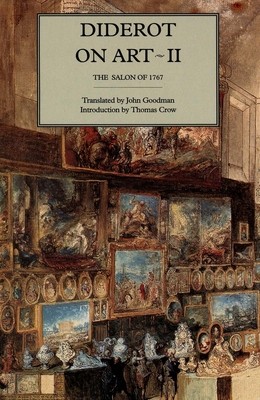
- We will send in 10–14 business days.
- Author: Diderot
- Publisher: Yale University Press
- Year: 1995
- ISBN-10: 0300062524
- ISBN-13: 9780300062526
- Format: 14 x 21.3 x 2.2 cm, softcover
- Language: English
- SAVE -10% with code: EXTRA
Reviews
Description
The eighteenth-century French philosophe Denis Diderot--the principal intelligence behind the Encyclopédie and the author of idiosyncratic fictional works such as Jacques the Fatalist and Rameau's Nephew--was also the first great art critic. Until now, however, Diderot's treatises on the visual arts have been available only in French. This two-volume edition makes the most important of his art-critical texts available in English for the first time.
Diderot's works are among the most provocative and engaging products of the French Enlightenment. Moreover, their ruminations on many issues of perennial interest (invention versus convention, nature versus culture, and technique versus imagination; the complex relations between economic reality and artistic achievement) give them a rare pertinence to current debates on the nature and function of representation. All the celebrated pieces are here: the rhapsodic dream meditation inspired by Fragonard's Corésus and Callierhoé; the incident-packed excursion through a set of landscapes by Joseph Vernet; the evocative consideration of the nature of ruins and historical nostalgia prompted by the first showing of works by Hubert Robert. But these famous passages can now be considered in their proper context, surrounded by meditations that are less well known but equally sparkling. The book also includes brief introductory texts and annotations by John Goodman that clarify the many references to contemporary Parisian culture, as well as an introduction by Thomas Crow that sets the texts in their historical and art-historical context.EXTRA 10 % discount with code: EXTRA
The promotion ends in 17d.13:38:58
The discount code is valid when purchasing from 10 €. Discounts do not stack.
- Author: Diderot
- Publisher: Yale University Press
- Year: 1995
- ISBN-10: 0300062524
- ISBN-13: 9780300062526
- Format: 14 x 21.3 x 2.2 cm, softcover
- Language: English English
The eighteenth-century French philosophe Denis Diderot--the principal intelligence behind the Encyclopédie and the author of idiosyncratic fictional works such as Jacques the Fatalist and Rameau's Nephew--was also the first great art critic. Until now, however, Diderot's treatises on the visual arts have been available only in French. This two-volume edition makes the most important of his art-critical texts available in English for the first time.
Diderot's works are among the most provocative and engaging products of the French Enlightenment. Moreover, their ruminations on many issues of perennial interest (invention versus convention, nature versus culture, and technique versus imagination; the complex relations between economic reality and artistic achievement) give them a rare pertinence to current debates on the nature and function of representation. All the celebrated pieces are here: the rhapsodic dream meditation inspired by Fragonard's Corésus and Callierhoé; the incident-packed excursion through a set of landscapes by Joseph Vernet; the evocative consideration of the nature of ruins and historical nostalgia prompted by the first showing of works by Hubert Robert. But these famous passages can now be considered in their proper context, surrounded by meditations that are less well known but equally sparkling. The book also includes brief introductory texts and annotations by John Goodman that clarify the many references to contemporary Parisian culture, as well as an introduction by Thomas Crow that sets the texts in their historical and art-historical context.

Reviews